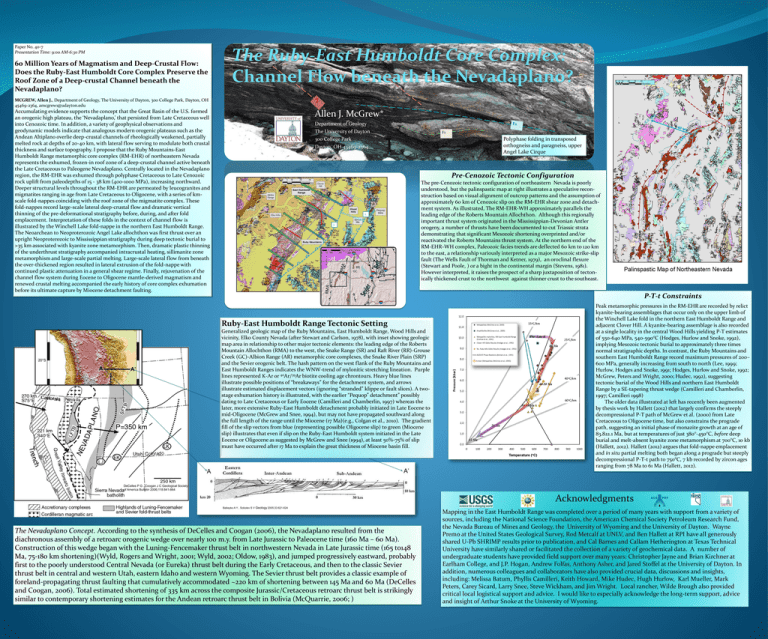RM-EHRchannelFlowGSA2012 - Geological Society of America
advertisement

Paper No. 40-7 Presentation Time: 9:00 AM-6:30 PM 60 Million Years of Magmatism and Deep-Crustal Flow: Does the Ruby-East Humboldt Core Complex Preserve the Roof Zone of a Deep-crustal Channel beneath the Nevadaplano? The Ruby-East Humboldt Core Complex: Channel Flow beneath the Nevadaplano? MCGREW, Allen J., Department of Geology, The University of Dayton, 300 College Park, Dayton, OH 45469-2364, amcgrew1@udayton.edu Accumulating evidence supports the concept that the Great Basin of the U.S. formed an orogenic high plateau, the ‘Nevadaplano,’ that persisted from Late Cretaceous well into Cenozoic time. In addition, a variety of geophysical observations and geodynamic models indicate that analogous modern orogenic plateaus such as the Andean Altiplano overlie deep-crustal channels of rheologically weakened, partially melted rock at depths of 20-40 km, with lateral flow serving to modulate both crustal thickness and surface topography. I propose that the Ruby Mountains-East Humboldt Range metamorphic core complex (RM-EHR) of northeastern Nevada represents the exhumed, frozen-in roof zone of a deep-crustal channel active beneath the Late Cretaceous to Paleogene Nevadaplano. Centrally located in the Nevadaplano region, the RM-EHR was exhumed through polyphase Cretaceous to Late Cenozoic rock uplift from paleodepths of 15 - 38 km (400-1000 MPa), increasing northward. Deeper structural levels throughout the RM-EHR are permeated by leucogranites and migmatites ranging in age from Late Cretaceous to Oligocene, with a series of kmscale fold-nappes coinciding with the roof zone of the migmatite complex. These fold-nappes record large-scale lateral deep-crustal flow and dramatic vertical thinning of the pre-deformational stratigraphy before, during, and after fold emplacement. Interpretation of these folds in the context of channel flow is illustrated by the Winchell Lake fold-nappe in the northern East Humboldt Range. The Neoarchean to Neoproterozoic Angel Lake allochthon was first thrust over an upright Neoproterozoic to Mississippian stratigraphy during deep tectonic burial to >35 km associated with kyanite zone metamorphism. Then, dramatic plastic thinning of the underthrust stratigraphy accompanied intracrustal heating, sillimanite zone metamorphism and large-scale partial melting. Large-scale lateral flow from beneath the over-thickened region resulted in lateral extrusion of the fold-nappe with continued plastic attenuation in a general shear regime. Finally, rejuvenation of the channel flow system during Eocene to Oligocene mantle-derived magmatism and renewed crustal melting accompanied the early history of core complex exhumation before its ultimate capture by Miocene detachment faulting. Allen J. McGrew* Department of Geology The University of Dayton 300 College Park Dayton, OH 45469-2364 F1 Polyphase folding in transposed orthogneiss and paragneiss, upper Angel Lake Cirque Pre-Cenozoic Tectonic Configuration The pre-Cenozoic tectonic configuration of northeastern Nevada is poorly understood, but the palinspastic map at right illustrates a speculative reconstruction based on visual alignment of outcrop patterns and the assumption of approximately 60 km of Cenozoic slip on the RM-EHR shear zone and detachment system. As illustrated, The RM-EHR-WH approximately parallels the leading edge of the Roberts Mountain Allochthon. Although this regionally important thrust system originated in the Mississippian-Devonian Antler orogeny, a number of thrusts have been documented to cut Triassic strata demonstrating that significant Mesozoic shortening overprinted and/or reactivated the Roberts Mountains thrust system. At the northern end of the RM-EHR–WH complex, Paleozoic facies trends are deflected 60 km to 120 km to the east, a relationship variously interpreted as a major Mesozoic strike-slip fault (The Wells Fault of Thorman and Ketner, 1979), an oroclinal flexure (Stewart and Poole, ) or a bight in the continental margin (Stevens, 1981). However interpreted, it raises the prospect of a sharp juxtaposition of tectonically thickened crust to the northwest against thinner crust to the southeast. P-T-t Constraints Ruby-East Humboldt Range Tectonic Setting Generalized geologic map of the Ruby Mountains, East Humboldt Range, Wood Hills and vicinity, Elko County Nevada (after Stewart and Carlson, 1978), with inset showing geologic map area in relationship to other major tectonic elements: the leading edge of the Roberts Mountain Allochthon (RMA) to the west, the Snake Range (SR) and Raft River (RR)-Grouse Creek (GC)-Albion Range (AR) metamorphic core complexes, the Snake River Plain (SRP) and the Sevier orogenic belt. The hash pattern on the west flank of the Ruby Mountains and East Humboldt Ranges indicates the WNW-trend of mylonitic stretching lineation. Purple lines represented K-Ar or 40Ar/39Ar biotite cooling age chrontours. Heavy blue lines illustrate possible positions of “breakaways” for the detachment system, and arrows illustrate estimated displacement vectors (ignoring “stranded” klippe or fault slices). A twostage exhumation history is illustrated, with the earlier “Pequop” detachment” possibly dating to Late Cretaceous or Early Eocene (Camilleri and Chamberlin, 1997) whereas the later, more extensive Ruby-East Humboldt detachment probably initiated in Late Eocene to mid-Oligocene (McGrew and Snee, 1994), but may not have propagated southward along the full length of the range until the Miocene (17 Ma)(e.g., Colgan et al., 2010). The gradient fill of the slip vectors from blue (representing possible Oligocene slip) to green (Miocene slip) illustrates that even if slip on the Ruby-East Humboldt system initiated in the Late Eocene or Oligocene as suggested by McGrew and Snee (1994), at least 50%-75% of slip must have occurred after 17 Ma to explain the great thickness of Miocene basin fill. Peak metamorphic pressures in the RM-EHR are recorded by relict kyanite-bearing assemblages that occur only on the upper limb of the Winchell Lake fold in the northern East Humboldt Range and adjacent Clover Hill. A kyanite-bearing assemblage is also recorded at a single locality in the central Wood Hills yielding P-T estimates of 550-640 MPa, 540-590°C (Hodges, Hurlow and Snoke, 1992), implying Mesozoic tectonic burial to approximately three times normal stratigraphic depths. In contrast, the Ruby Mountains and southern East Humboldt Range record maximum pressures of 200– 600 MPa, generally increasing from south to north (Lee, 1999; Hurlow, Hodges and Snoke, 1991; Hodges, Hurlow and Snoke, 1992; McGrew, Peters and Wright, 2000; Hudec, 1992), suggesting tectonic burial of the Wood Hills and northern East Humboldt Range by a SE-tapering thrust wedge (Camilleri and Chamberlin, 1997; Camilleri 1998) The older data illustrated at left has recently been augmented by thesis work by Hallett (2012) that largely confirms the steeply decompressional P-T path of McGrew et al. (2000) from Late Cretaceous to Oligocene time, but also constrains the prograde path, suggesting an initial phase of monazite growth at an age of 83.8±1.1 Ma, but at temperatures of just 380°-450°C, before deep burial and melt-absent kyanite zone metamorphism at 700°C, 10 kb (Hallett, 2012). Hallett (2012) argues that fold-nappe emplacement and in situ partial melting both began along a prograde but steeply decompressional P-T-t path to 750°C, 7 kb recorded by zircon ages ranging from 78 Ma to 61 Ma (Hallett, 2012). DeCelles P G , Coogan J C Geological Society of America Bulletin 2006;118:841-864 Acknowledgments ©2006 by Geological Society of America Babeyko A Y , Sobolev S V Geology 2005;33:621-624 The Nevadaplano Concept. According to the synthesis of DeCelles and Coogan (2006), the Nevadaplano resulted from the diachronous assembly of a retroarc orogenic wedge over nearly 100 m.y. from Late Jurassic to Paleocene time (160 Ma – 60 Ma). Construction of this wedge began with the Luning-Fencemaker thrust belt in northwestern Nevada in Late Jurassic time (165 to148 Ma, 75-180 km shortening)(Wyld, Rogers and Wright, 2001; Wyld, 2002; Oldow, 1983), and jumped progressively eastward, probably first to the poorly understood Central Nevada (or Eureka) thrust belt during the Early Cretaceous, and then to the classic Sevier thrust belt in central and western Utah, eastern Idaho and western Wyoming. The Sevier thrust belt provides a classic example of foreland-propagating thrust faulting that cumulatively accommodated ~220 km of shortening between 145 Ma and 60 Ma (DeCelles and Coogan, 2006). Total estimated shortening of 335 km across the composite Jurassic/Cretaceous retroarc thrust belt is strikingly similar to contemporary shortening estimates for the Andean retroarc thrust belt in Bolivia (McQuarrie, 2006; ) Mapping in the East Humboldt Range was completed over a period of many years with support from a variety of sources, including the National Science Foundation, the American Chemical Society Petroleum Research Fund, the Nevada Bureau of Mines and Geology, the University of Wyoming and the University of Dayton. Wayne Premo at the United States Geological Survey, Rod Metcalf at UNLV, and Ben Hallett at RPI have all generously shared U-Pb SHRIMP results prior to publication, and Cal Barnes and Callam Hetherington at Texas Technical University have similarly shared or facilitated the collection of a variety of geochemical data. A number of undergraduate students have provided field support over many years: Christopher Jayne and Brian Kirchner at Earlham College, and J.P. Hogan, Andrew Folfas, Anthony Asher, and Jared Stoffel at the University of Dayton. In addition, numerous colleagues and collaborators have also provided crucial data, discussions and insights, including: Melissa Batum, Phyllis Camilleri, Keith Howard, Mike Hudec, Hugh Hurlow, Karl Mueller, Mark Peters, Carey Sicard, Larry Snee, Steve Wickham, and Jim Wright. Local rancher, Wilde Brough also provided critical local logistical support and advice. I would like to especially acknowledge the long-term support, advice and insight of Arthur Snoke at the University of Wyoming. Age and Origin of the Winchell Lake Fold-Nappe The Winchell Lake Fold-nappe The Ruby Mountains and East Humboldt Range expose a series of recumbent isoclinal folds including the King Peak nappe, the Lamoille Canyon nappe and the Soldier Peak nappe in the central and northern Ruby Mountains as well as the Winchell Lake nappe depicted in the crosssection above. The Winchell Lake fold-nappe preserves the highest pressure metamorphic assemblages documented in the RM-EHR and is cored by the only known exposures of Archean rock in the state of Nevada. Like all the fold-nappes, the lower limb of the fold hosts dramatically greater proportions of leucogranite than the upper limb despite the observation that leucogranites are commonly involved in folding, suggesting that crustal scale mobilization represented by the folds was localized near the roof of the migmatite complex during decompressional peak metamorphism and (according to Hallett, 2012) less than 5 million years after peak pressures were achieved. All these observations are compatiblek with the channel flow hypothesis. As partial melting mobilized the deeper crust, the fold-nappes flowed down pressure gradients away from the over-pressured roots of the thrust belt to the northwest. Conclusions and Future Work 1) The Ruby Mountain-East Humboldt Range – Wood Hills metamorphic core complex preserves an exceptional record of polyphase magmatism and widespread deep-crustal flow extending from Late Cretaceous to Neogene time that could be plausibly related to channel flow beneath the Nevadaplano. 2) Planned testing of the channel flow hypothesis will focus on an integrated approach incorporating high resolution SIMS geochronology and isotope geochemistry to better constrain the history and character of deep-seated magmatism in the RM-EHR in relation to major structural features such as the WLN and other fold-nappes and the Cenozoic mylonitic shear zone. 3) Previous work in the RM-EHR shear zone revealed a fundamental transition in quartz crystallographic textures with increasing depth beneath the mylonitic shear zone associated with a reversal in bulk shear sense. Future work will explore the significance of this transition in light of the channel flow hypothesis. Metcalf, pers. Comm., 2012 Selected References Chronology of Magmatism As illustrated by the U-Pb SIMS results generously shared by Metcalf and Drew (2011) above and the Hafnium results shared by Barnes and Hetherington below, the RM-EHR preserves a remarkably complex and persistent record of magmatism from >100 Ma to ~30 Ma. It is likely that the large-scale presence of crustal partial melts played a crucial role in localizing crustal strain. See adjacent poster by Romanoski et al., 2012 Camilleri, P.A., and Chamberlain, K.R., 1997, Mesozoic tectonics and metamorphism in the Pequop Mountains and Wood Hills region, Northeast Nevada; implications for the architecture and evolution of the Sevier Orogen: Geological Society of America Bulletin, v. 109, p. 74-94. Camilleri, P., 2010a, Geologic Map of the Wood Hills, Elko County,Nevada: Nevada Bureau of Mines and Geology Map Series, v. M172, . Camilleri, P.A., 2010b, Geologic Map of the northern Pequop Mountains, Elko County, Nevada: Nevada Bureau of Mines and Geology Map Series, v. M171, . Camilleri, P.A., 1998, Prograde metamorphism, strain evolution, and collapse of footwalls of thick thrust sheets; a case study from the Mesozoic Sevier hinterland, U.S.A: Journal of Structural Geology, v. 20, p. 1023-1042. Colgan, J. P., and Henry, C. D., 2009, Rapid middle Miocene collapse of the Mesozoic orogenic plateau in north-central Nevada: International Geology Review, v. 51, no. 9-11, p. 920-961. Colgan, J.P., Howard, K.A., Fleck, R.J., and Wooden, J.L., 2010, Rapid middle Miocene extension and unroofing of the southern Ruby Mountains, Nevada Tectonics, v. 29, , doi: 10.1029/2009TC002655. DeCelles, P.G., and Coogan, J.C., 2006, Regional structure and kinematic history of the Sevier fold-and-thrust belt, central Utah: Geological Society of America Bulletin, v. 118, p. 841-864, doi: 10.1130/B25759.1. Hallett, B.W., 2012, Metamorphic history and timescale of cooling and exhumation of partially melted rocks: Studies in the North American Cordillera, Ph. D. Thesis, Rensselaer olytechnic Institute, 213 p. Henry, C.D., 2008, Ash-flow tuffs and paleovalleys in northeastern Nevada; implications for Eocene paleogeography and extension in the Sevier hinterland, northern Great Basin: Geosphere, v. 4, p. 1-35. Hodges, K.V., Hurlow, H.A., and Snoke, A.W., 1992, Thermal evolution of a portion of the Sevier Hinterland; the northern Ruby Mountains-East Humboldt Range and Wood Hills, northeastern Nevada: Tectonics, v. 11, p. 154-164. Howard, K.A., Wooden, J.L., Barnes, C.G., Premo, W.R., Snoke, A.W., and Lee, S.-., 2011, Episodic growth of a Late Cretaceous and Paleogene intrusive complex of pegmatitic leucogranite, Ruby Mountains core complex, Nevada, USA: Geosphere, v. 7, p. 1220-1248, doi: 10.1130/GES00668.1. Lee, S., Barnes, C.G., Frost, C.D., Howard, K.A., and Snoke, A.W., 2003, Petrogenesis of Mesozoic, peraluminous granites in the Lamoille Canyon area, Ruby Mountains, Nevada, USA: Journal of Petrology, v. 44, p. 713-732. Lush, A.P., McGrew, A.J., Snoke, A.W., and Wright, J.E., 1988, Allochthonous Archean basement in the northern East Humboldt Range, Nevada: Geology (Boulder), v. 16, p. 349-353. McGrew. A.J., and Snee, L.W., 1994, 40Ar/39Ar thermochrono-metric constraints on the tectonothermal evolution of the northern East Humboldt Range metamorphic core complex, Nevada: Tectonophysics, v. 238, p. 425-450. McGrew, A.J., Peters, M.T., and Wright, J.E., 2000, Thermobarometric constraints on the tectonothermal evolution of the East Humboldt Range metamorphic core complex, Nevada: Geological Society of America Bulletin, v. 112, p. 45-60. McGrew, A.J., and Snoke, A.W. 2010, SHRIMP-RG U-Pb isotopic systematics of zircon from the Angel Lake orthogneiss, east Humboldt Range, Nevada; is this really Archean crust? Discussion, Geosphere, v. 6, p. 962-965. Metcalf, R.V., and Jordan, D., 2011, Cretaceous and Eocene-Oligocene U-Pb zircon migmatite ages from the East Humboldt Range metamorphic core complex, Nevada: Geological Society of America Abstracts with Programs, v. 43, no. 5, p. 275. Premo, W.R., Castineiras, P., and Wooden, J.L., 2008, SHRIMP-RG U-Pb isotopic systematics of zircon from the Angel Lake orthogneiss, east Humboldt Range, Nevada; is this really Archean crust? Geosphere, v. 4, p. 963-975. Premo, W.R., Castineiras, P., and Wooden, J.L., 2010, SHRIMP-RG U-Pb isotopic systematics of zircon from the Angel Lake orthogneiss, east Humboldt Range, Nevada; is this really Archean crust? Geosphere: Reply v. 64, p. 966-972. Snoke, A.W., McGrew, A.J., Smithson, S.B., and Valasek, P.A., 1990, A crustal cross-section for a terrain of superimposed shortening and extension; Ruby Mountains-East Humboldt Range metamorphic core complex, Nevada: , Fountain, D.M., ed, NATO ASI Series.Series C: Mathematical and Physical Sciences, v. 317, p. 103-135.






